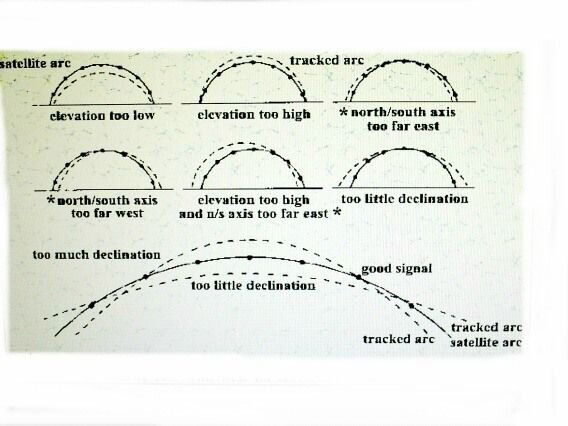I tried everything and many times had to start over just to get those original numbers back.
That is exactly what I did. I started over from the beginning.
When I went up this morning, I told my wife that today was going to be the day that I finished it. She asked "what if it doesn't perform like you think it should"? I told her that I would blow it off the roof if it didn't.
Thank God it is finally over!!!
I did precisely what Mike told me to do. Took a flat piece of steel to lay across the elevation bar and put my protractor and got my exact elevation, then laid the same piece across the back of the mounting ring to get the total angle. Then set the declination just over 5 degrees of difference. I tightened that down and didn't touch it again.
I adjusted the center for best signal, then started taking readings. I moved the Focal Length back out to the farthest point and tried moving in with both .40 and .38 until I got the best readings across the arc. It still wasn't giving me much and in some cases I was losing ground.
About 3:00, I was on G17 and ONN, and sitting there wondering why it wasn't maxed out. I had been doing the push down, lift up, but it just wasn't giving me any indication of what it needed. I had already tried moving the assembly in the direction that gave me some improvement yesterday, but that didn't help. I usually always move the whole assembly from side to side while at the center to keep the dish steady. This time, I decided to make ONN max out while I was looking at it so I loosened up the bolts and swung the assembly until ONN was at 99% and locked it down.
That did the trick and from there on all the others fell in place after adjusting their positions from the twist.
Here are the numbers from the Pansat compared to yesterdays.
G15 133W C-Band 3747 H California Channel 45% SQ now at 45%
G27 129W White Springs Ku 10-15% SQ now 75%
G10 127W 11720 V is at 30% now at 90%
G11 91W 12060 V 45% SQ now at 45% as compensation for the ends better quality.
G11 91W C-Band 11720 H bouncing between 90-99% SQ now at a solid 90% reflective of the Ku numbers on that position.
G17 74W 11732 H ONN is now at 90% SQ 99%
AMC6 72W 12053 V satops mux 45% SQ now at 75%.
Tried AMC3 and couldn't even pull in Montana PBS. Montana PBS at 60% SQ
Tried AMC2 and couldn't get the test card digital or analog. got the AMC2 (AMC16) digital test card at 89% SQ and got the analog test card.
I set up a DBS satellite just to make sure the used DTV LNBF was working and it works fine.
I unhooked the Pansat and hooked up the Traxis just for comparison so here are it's numbers:
G15 133W C-Band 3747 H California Channel Pansat 70% - Traxis 70%
G27 129W White Springs Ku Pansat 45% - Traxis 74%
G10 127W 11720 V Pansat 90% - Traxis 72%
G11 91W 12060 V 45% SQ Pansat 45% - Traxis 63%
G11 91W C-Band 11720 H Pansat 90% - Traxis 77%
G17 74W 11732 H ONN Pansat 99% - Traxis 80%
AMC6 72W 12053 V satops mux Pansat 75% - I still couldn't get these to come in on the Traxis. Very Strange.
Tried AMC3 and couldn't even pull in Montana PBS. Montana PBS at Pansat 60% SQ - Traxis 73%
Tried AMC2 and couldn't get the test card digital or analog. Pansat 89% SQ - Traxis I forgot to write it down.

The Traxis meter readings are very strange higher on some and lower on others. It is not consistent.
So the F/D ratio is .38 and the Focal Length is 47-5/8". That is 1/4" inside the mouth of the wave-guide.
I would put the dish overall performance right up there with the Birdview and probably the number 2 spot of all 5 BUDS.
I am going to run the coax into the house tomorrow afternoon and I will have final pictures.
Thanks for everyone's help, and thanks to Mike Kohl for forcing me back to the basics.
Fred


